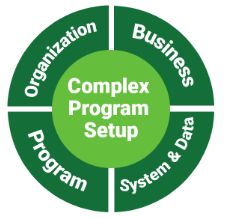Many complex tech programs are not set up for success
The update or new implementation of an ERP system (Enterprise Resource Planning) – such as SAP, Microsoft Dynamics, or Oracle – is a perfect example for complex tech programs that often fail. Regardless of the size of the organization or its geographical location, many seem to struggle – and often the foundation for failure is laid at the very beginning.
For example, a client undertook a major program with a duration of more than five years to get "S/4HANA ready". However, what exactly had to be achieved to be more ready for S/4HANA had never been formulated and documented.Another big corporate client was introducing a new SAP system, with multiple delays. When reviewing the program, it became clear that the objectives were not formulated precisely enough and became even more blurry over time: while one part of the stakeholders was aiming for a "state-of-the-art", fully tailored new solution, the other part was aiming for an "economic, much cheaper than the current solution, close to the standard". This set-up was leading to a domino effect of misalignments and challenges on the journey.
The seemingly endless list of ERP and complex tech programs that faced severe disruptions leads to the question: what are the root causes?
Poor setup and initiation pave their way to significant disruption in later stages of the program
Of course, while a good beginning cannot guarantee success, if turning the proverb in the title around, it is indisputably true: Too often the reasons for extreme challenges and failure of complex tech programs are found right at the beginning – during the set-up phase of the program.
Some of the most severe challenges to program success can be summarized in seven categories:
- The defined business and technology program objectives are not clear. Goals often fail to be described precisely enough nor are they quantified. Further, they are rapidly changing throughout programs, leading to a constant lack of focus of program activities.
- The alignment between business and technology functions is insufficient, and there is no underlying consensus and mutual understanding among stakeholders prior to starting program execution, which results in disputes and delays.
- The program lacks a senior sponsor with sufficient and required authority and time commitment within the business, leading to a constant need for justification, competition, and ultimately reprioritization with other programs.
- There is no established communication approach, which leads to stakeholder and program team misalignments, disputes, and timely discussions which delay progress.
- There is not a sufficient budget allocated and the pressure to reduce costs is too high to provide sufficient resources and time to complete the program. Budget discussions and shortenings are the consequence and often lead to abrupt scope or resource changes with negative ripple effects for the whole program.
- There is no program management approach and no governance in place. This can often be observed when no specific methodology has been applied and the program management has been given little authority. Many times, this is accompanied by a lack of risk and quality management as well as insufficient tools being selected to steer the program. The result is a poor oversight of activities and uncertainty of risks and quality standards of program deliverables.
- There is a lack of organizational preparedness for long-term periods – complex tech programs are marathons, not sprints: Often organizations do not have enough awareness that complex tech programs can last several years and are not prepared to assign top resources over a longer period of time.
Simple rules, big impact
We have experienced and advised many clients who managed to successfully master their complex tech program. They all had one thing in common – they invested considerable time and effort in the set-up and planning of the program and carefully prepared for business and change management. In summary, our clients followed simple yet effective rules because "a good beginning makes a good ending":

- Business Readiness: It may sound simple, but a complex tech program should have precise and measurable business objectives. These objectives must be agreed between the business and technology function and should be communicated and aligned with all relevant stakeholders. To define the objectives and to ensure business readiness, the future business model as well as the target operating and steering model need to be considered.
- System, Data, and IT Readiness: To be successful, the technical and IT architecture aspects should be taken into consideration. Especially the solution design and roadmap, the master data and migration approach, cybersecurity and authorization aspects, and the overall IT operating model need to be carefully analyzed to avoid bad surprises throughout the program.
- Program Readiness: It is necessary to assess if the program itself is set up correctly and is ready for execution. The program structure and planning, the organization, the business case, and the governance and risk framework should be in focus here. While selecting the right approach, it must also be considered which tools are required to execute the program effectively and efficiently.
- Organization Readiness: Decision makers must select an effective change management and communication plan, an appropriate resource plan, as well as the suitable external partner . Overall, it is key to choose an appropriate sponsor who can ensure the program has enough priority and financial resources. An experienced program manager needs to be appointed during initiation to have full control from the beginning and to select the right team. Both sponsor and program manager can then make sure that key resources are available, and the organization is navigated effectively.
If you would like to assess your current practices on how to set up complex IT programs or are in the middle of already doing so, please get in touch with us to continue the conversation. We have the expertise to support you when it really matters.
Look out for our next article focused on successful program execution and governance.
The content of this article is intended to provide a general guide to the subject matter. Specialist advice should be sought about your specific circumstances.



